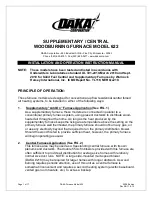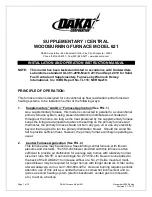
14
MAINTENANCE
Clinker formation can occur from a number of different causes or a combination of causes. Some of these are
as follows:
•
Too hot a fire (too much draft)
• Too shallow a bed of coals
• Too deep a bed of coals
• Excess shaking
•
Poking the fire from the top
• Poor quality coal – excess ash content
•
Too little air (draft) after a long hot fire
SAFETY
Whenever a loading door is opened, it always should be cracked slightly before fully opening to allow oxygen
to enter and burn any combustible gases that are present. Failure to do this could result in sudden ignition of the
unburned gases when the door is opened.
A furnace never should be filled with excess coal so that the flue gas exit is in anyway blocked or impeded.
Burning coal generates carbon monoxide. If the flue gas exit is blocked, the carbon monoxide can be forced
out of the furnace into the room with possible fatal consequences. Never burn coal in any furnace that does not
have an airtight, unified chimney system. The furnace should be used only with chimney systems that provide a
strong, reliable draft. With the exception of the start up period, an ash pit door never should be left open. Do not
use an automatic stoker with this furnace.
Failure to follow these instructions may result in poor efficiency, excessive corrosion of the heat exchanger and
the possibility of a creosote fire.
DAILY
Furnace model with grates must have the ashes removed daily. This is to prevent warping of the grates and
prevent any interruption in the combustion air flow. Ashes must be put in a metal container with a lid on it before
moving the ashes to the outdoors.
MONTHLY
Furnace heat exchanger and fluepipe – Furnaces without grates must have ashes removed on a minimum of a
monthly basis depending on the ash build up. The complete heat exchanger and flue pipe should be thoroughly
inspected for creosote deposits, ash buildup, etc. Creosote or ash deposits must be removed by scraping and/
or brushing the deposits from the heat exchanger surfaces. An industrial vacuum cleaner may be used to assist
in the removal of such deposits. A complete cleaning must be done immediately at the end of each heating
season. If this is not done, condensation from the summer , or any other source, will mix with the ash or creosote
and cause corrosion of the heat exchanger. Corrosion is not covered under warranty.
NOTE: Establish a routine for the storage of fuel, care of the appliance, and firing techniques. Check daily for
creosote buildup until experience shows how often cleaning is necessary. Be aware that the hotter the fire, the
less creosote is deposited and weekly cleaning may be necessary in mild weather even though monthly cleaning
may be enough in the coldest months. Have a clearly understood plan to handle a chimney fire.
CHIMNEY
Chemical chimney cleaners are not recommended as they could damage the furnace heat exchanger and
flue pipe.
One of the most efficient methods to clean a chimney is to lower a stiff brush (chimney brush) tied to a heavy
weight down the chimney on a rope. Work the brush up and down the chimney to scrape the accumulated
creosote and soot off the chimney walls. Remove the residue from the cleanout at the base of the chimney.
SEMI-ANNUALLY
Draft Fan – oil motor with #20 non-detergent oil.
ANNUALLY
Burner Motor and Blower Motor – oil with #20 non-detergent oil. In the spring, after the furnace is shut down for
the summer, clean the heat exchanger of all soot, ash and creosote accumulation, remove all ashes, clean the
flue pipe and clean the chimney.
Summary of Contents for CL 115C
Page 7: ...7 Figure 7 FLUE PIPE CONNECTION MINIMUM INSTALLATION CLEARANCES...
Page 17: ...17 Figure 11 TYPICAL A C COIL INSTALLATION...
Page 18: ...18 Figure 12 WIRING DIAGRAM WITH AIR CONDITIONING...
Page 19: ...19 Figure 13 CL SERIES WIRING DIAGRAM...
Page 23: ...23 Figure 17 1E AERO PGB 220 370 GAS BURNER EXPLODED ASSLY...
Page 25: ...25 Figure 17 1G THERMO DISC MOUNTING ON BURNER PLATE...
Page 26: ...26 Figure 17 2A AERO BURNER EXPLODED ASSEMBLY...
Page 28: ...28 Figure 17 3A BECKETT BURNER EXPLODED ASSEMBLY...
Page 56: ...Figure 17 3A ASSEMBLAGE EXPLOD DU BR LEUR BECKETT...
Page 58: ...FIG 17 2A BR LEUR AERO ASSEMBLAGE CLAT...
Page 59: ...FIG 17 1G LE DISQUE DE THERMO MONTE SUR LA PLAQUE DE BR LEUR...
Page 64: ...FIG 13 C BLAGE DE LA S RIE CL...
Page 74: ...FIG 7 RACCORDEMENT DU TUYAU DE FUM E ET ESPACE LIBRE MINIMAL FIG 8 EMPLACEMENTS DES COMMANDES...















































